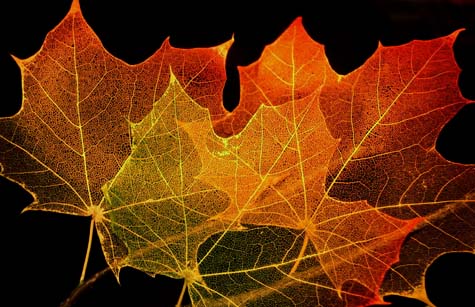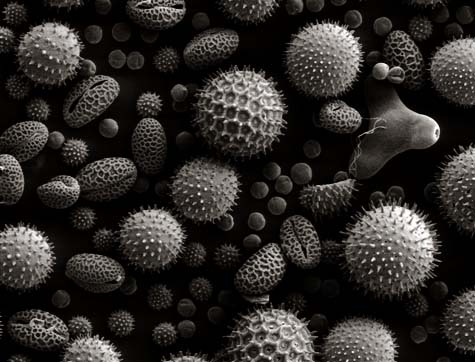 [Image: The internal structure of maple leaves, via Wikimedia].
[Image: The internal structure of maple leaves, via Wikimedia].
In 1997, Japanese composer Mamoru Fujieda released a CD called Patterns of Plants. The album featured “melodic material” that Fujieda developed using the “surface-electrical potential” of plant leaves.
In other words, he transformed leaves into sound.
You can hear excerpts from Patterns of Plants at the iTunes store.
Bear in mind, however, that you’re not really listening to the electrical circuitry of amplified plantlife; the music is pretty stylized. We read, for instance, that every track combines “alternate tuning systems (just intonation, Pythagorean) with traditional instruments of China and Japan (sho, koto and the ancient 25-stringed zither, the hitsu),” creating a “bizarre and fascinating mixture of European Medieval music, the traditions of Asia and modern science.”
In fact, Fujieda’s musical translation of plantlife – sonatas encoded in cell structure and root – is similar to work done by composer Yuji Dogane. Dogane is known for creating a device called the Ecological Plantron. Dogane’s Plantron “measures the minute electrical changes which flow across the surface of the leaves of plants, and changes them into sounds.”
 [Image: A leaf, via Wikipedia].
[Image: A leaf, via Wikipedia].
In any case, I was reminded of Fujieda’s music today after reading a short article about the relationship between plantlife and sound in this week’s issue of New Scientist.
There we read that Korean scientists “claim to have identified two genes in rice that respond to sound waves.” These would be “sound-sensitive genes” – or “sound-responsive genes” – and they “could be attached to other genes to make them respond to sound too.”
The genes rbcS and Ald became more active at 125 and 250 hertz and less active at 50 hertz. As both are known to respond to light, the researchers repeated the tests in the dark and found that the two genes still responded to sound.
Though these results “have been greeted with profound scepticism” by other researchers, if the tests can be repeated they’d indicate “that sound could be an alternative to light as a gene regulator.”
It’s not photosynthesis, then, but audiosynthesis. Geneto-acoustic biology.
Even more interesting – and I absolutely love this:
If the researchers are correct, they say their discovery could enable farmers to switch specific crop genes on and off, such as ones for flowering, by blasting sound into the fields.
Which leaves me wondering if, someday, there might be whole warehouses full of hybridized crops growing vigorously in darkness, with B-flat droning from unseen speakers.
Somewhere below, in a soundproof lab, scientists subject single seeds to six thousand hours of shifting frequencies, synthesizing vitamins, coaxing corn into wheat. It’s industrial agri-alchemy.
You break-in, unaware of what the building really is, only to switch on your flashlight, terrified by the constant thunder, to see a thousand stalks of corn vibrating in rows all around you…
The ground is shaking and the air is full of pollen.
 [Image: Pollen, via Wikipedia].
[Image: Pollen, via Wikipedia].
Will we grow tomorrow’s crops inside recording studios?
Or, ten years from now, you stumble upon vast fields of barley stretching off to the horizon, and there are weatherproof speakers placed every three hundred feet, emitting F-sharp – though the exact sound they’re playing has been patented.
You can hear the farm ten miles away.
Might sound – or infrasound – have as great an impact on genetic mutation as ultraviolet radiation from the sun?
 [Image: A field of barley, via Wikipedia].
[Image: A field of barley, via Wikipedia].
And what of our genes, perhaps shaken into new configurations by exposure to the rarest of frequencies? Are we genetically affected by sound?
Further, might there be a civilization somewhere whose “music” is really a complicated form of genetic stimulation? For every concert you attend, you become something other – acoustically moving through new forms of alteration.
Great post, Geoff, and the image series is extraordinary.
you should check out michael prime’s l-fields (and other recordings). “Some records will please you, others will disturb or mystify you. And then some rare specimens will extend your conception of life. Michael Prime’s L-fields is of the latter category. The source material on L-fields consists of bioelectrical recordings of hallucinogenic plants. Yep. Prime records the fluctuations of the electric field of a plant, fluctuations that trigger an oscillator. Prime later compresses, overlays, and integrates sounds from the surrounding environment to the signal and voilà: through a work aesthetically close to electroacoustics, the listener is invited to hear a plant live its life! L-fields delivers three experiments of this type (between 16 and 21 minutes each) with three different species: Cannabis sativa, Amanita muscaria, and Lophophora williamsii. Why all hallucinogenic plants? Because they had such an influence on the music of the last four decades it is about time you hear their music. The result is a fascinating organic music, out of this world and yet at the heart of our world. Composer David Dunn made some in situ environmental recordings in the 1970s-1980s; he used environments like the Grand Canyon to spatialize his music and instructed the musicians to interact with manifestations from the ecosystem (like nearby birds, for instance). But Michael Prime goes beyond this technique: instead of modifying the music in order to get a reaction from the environment, he modifies the environment (accentuating ambient light, touching the plant, etc.) to stimulate modifications in the internal “music” of plants. Simply fascinating. The four-and-a-half-stars rating goes as much to the context of artistic production at play than to the result itself, since one cannot separate the two when evaluating this album.” http://www.sonoris.org/son08.html
Reminds me of the work by Masaru Emoto:
http://en.wikipedia.org/wiki/Masaru_Emoto
He claims that thoughts and music can make crystals in water take different shapes, for example, some classical music creates a nice looking crystal, while heavy metal makes a chaotic looking crystal.
Very interesting stuff.
One day, a ‘minimalist’ DJ will will grow the perfect hip-hops on a converted dance floor, thus producing the world’s first sonic micro-brew.
About the whole “growing crop using sound” thing. There’s already something called ‘Sonic Bloom’. It’s really quite fascinating to read about (if it’s your kind of thing that is). The Sonic Bloom thingy combines sound (from a speaker) with a specially mixed fluid that contains all the essential stuff plant need to grow healthily. You spray some of that stuff on the leafs or roots(?) and turn on the music. What ensues is totally awesome. *_* check it out.
I love reading your blog, how it sways from scientific fact to daydreams and back, then melts into all-subsuming time. Please don’t ever stop.
(But please maybe put blank lines between the paragraphs or at least indent them?)